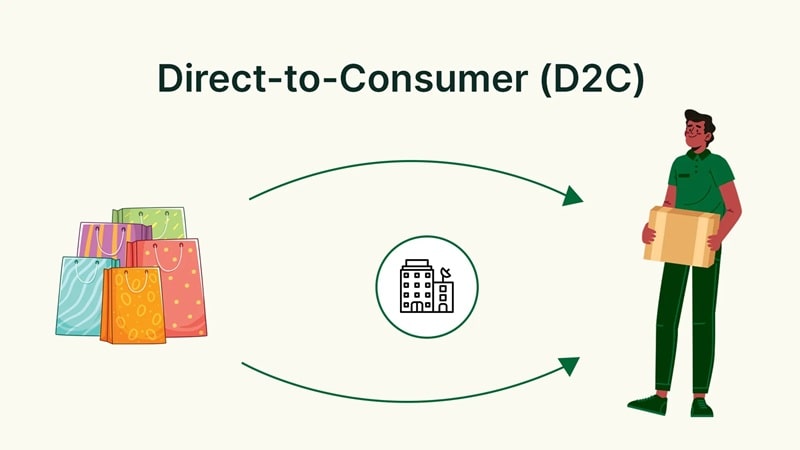Direct-to-customer? Yes, this type of business model is super easy to understand, but before that, you should know that in the traditional way of doing business, there is a lot that goes in the middle. For example, whatever you buy in the market or store nearby, that has to get to you by some mean, and there are a lot of middlemen involved in that process, like getting the products from actual manufacturer, then transporting it in different locations, giving it to retail outlets, from where you can buy the actual product as a customer.
But the D2C business model bypasses all of it, and this is where the makers of the products directly sell to the customer. So, now let’s get to know it a little better, like the proper definition, the real-life examples, the positive side of things with D2C, and the challenges that come along. Here we go.

What Is the D2C Business Model?
The D2C business model is just the way it sounds, like businesses or companies delivering their goods directly to the end-users, not using brick-and-mortar stores or any intermediaries whatsoever. Imagine this scenario: if a firm produces sneakers and sells them via their website directly to you, that means D2C is working.
Customer experience is under the full control of companies as they have directly handled all the aspects, starting from marketing, sales, and customer service. A major number of D2C brands are functioning via their respective websites or mobile applications, and sometimes through social media platforms as well. Customers can find new products at these places, conduct transactions, and even get in touch with the customer support team. That’s how it usually goes.
D2C has the excellent thing of a direct connection between a brand and a customer, where no intermediaries are involved. Through this communication, companies get customer feedback, follow purchase patterns, and use that information to develop improved products as well as make the shopping experience more customer-oriented. Since online shopping has taken over and become the standard, the D2C approach has been gaining ground against actual physical stores.
Real-World Examples of D2C Companies
In order for you to fully understand the concept of this type of business model, you should get to know a few companies that have successfully implemented it. Here:
- Warby Parker
- Dollar Shave Club
- Glossier
- Casper
- Allbirds
D2C Business Model Advantages
1. Better Customer Understanding
Companies have the opportunity to observe buying trends and receive feedback as a result of their direct relationships with customers. This allows them to enhance their products and provide customized suggestions.
2. Higher Profit Margins
When the sellers don’t have to share their income with third-party retailers, they are the ones who get the largest part of the money. This, in turn, allows them to have more freedom with their prices and generate more profits.
3. Faster Growth and Reach
Brands can go beyond geographical borders by selling online, without the need for an actual physical store in place. Such a capacity for scalability is what is considered the biggest benefit of direct sales.
4. More Agility and Innovation
D2C brands are able to introduce or even test new products in a short time. They are not required to go through the long retail approval process, and hence, they can respond to the market demand in a very efficient manner.
5. Stronger Brand Loyalty
Trust is built sometimes by more than just one regular engagement but also through emails, websites, and social media. Nowadays, that’s how it is. When a customer feels connected to the brand, he will not only return but also recommend it to other people.
6. Full Control Over Operations
Every aspect of the business, such as pricing, marketing, and even shipping, is taken care of inside the company. Through this, businesses can not only ensure that their brand is consistent but also quickly tackle any issue that pops up.
7. Lower Entry Barrier for Startups
It is not necessary for you to have a large retail setup to be able to initiate a D2C brand. What then? Just having a good product, a well-built website, and some simple marketing might suffice for you to make a start.
D2C Business Model Disadvantages
1. Heavy Online Competition
The internet is highly saturated. And we all know it by this point, don’t we? There are numerous brands that are selling the same or similar products; hence, it is very challenging to rise above the competition without having a well-thought-out plan.
2. Operational Load on the Brand
The company/business is responsible for the entire process from order management to customer support, delivery, and returns. If the company doesn’t have the appropriate systems in place, the situation can go beyond their control and become a mess of various tasks.
3. Higher Marketing Costs
When your brand isn’t featured in any store, all the efforts to bring you new customers rely solely on paid ads, content, and outreach. That’s a pain, but if you know your marketing game, this can very well result in your favor. Like, huge success down the line. Though, such expenses can escalate in no time.
4. Risk of Growing Too Fast
Unexpectedly higher orders might lead to inventory problems or shipping delays. That could be a good thing if you know how to handle such a situation, but if there isn’t a scalable backend, expanding can negatively affect customer experience.
5. Full Responsibility for Risks
Brands have the responsibility to take care of everything, starting from securely managing user data up to ensuring the quality of the products and taking back. A failure in any one of these can cause a brand’s reputation to go down along with customer trust.
6. Returns and Refunds Can Hurt Profits
Managing returns in the house is not only time-consuming but also increases the cost. A high rate of returns, particularly in sectors such as clothing, is capable of diminishing the profit margins of the company. And we’re talking about a big margin here.
Conclusion
That’s pretty much it. This definition, the examples, and pros and cons are more than enough for you to understand how this D2C business model works and whether you should take part in it or not. All in all, now you’re ready to form your own conclusion regarding this.



